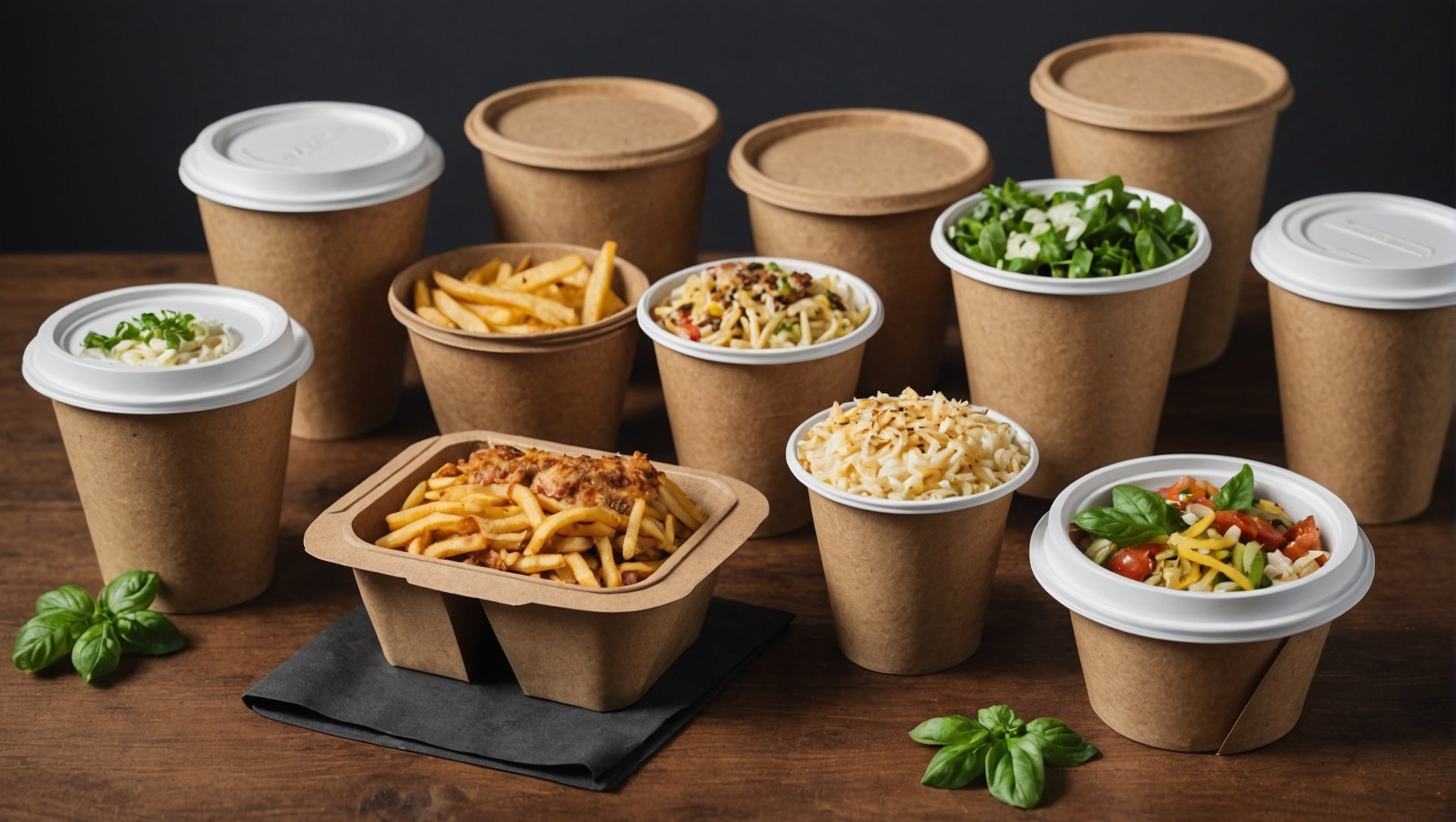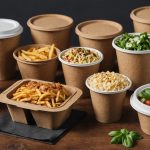Sustainable cafes looking to enhance their take-out options now have innovative biodegradable packaging solutions at their fingertips. These advancements not only reduce environmental impact but also align with consumer demands for eco-friendly choices. Discover how these revolutionary materials are transforming the cafe experience, ensuring your delicious offerings don’t come at the planet’s expense. Your journey to sustainable packaging begins here, where taste and responsibility coexist.
Revolutionary Biodegradable Packaging Innovations for Sustainable Cafes with Takeaway Options
In the era of increasing environmental awareness, the way we package and consume food, especially in cafes and takeaway services, is undergoing a significant transformation. The shift towards sustainable packaging is not just a trend, but a necessity to reduce the staggering amounts of plastic waste and mitigate the environmental impact of traditional packaging methods. Here, we delve into the innovative world of biodegradable packaging, exploring its benefits, practical applications, and the challenges it poses.
In parallel : Revolutionizing Café Ordering: Innovative Tech Solutions for a Seamless Experience
The Need for Sustainable Packaging
The food industry, particularly cafes and takeaway services, has long been criticized for its heavy reliance on single-use plastics. These plastics contribute significantly to waste and pollution, with many ending up in landfills or oceans. According to various studies, traditional plastic packaging is responsible for a substantial portion of global greenhouse gas emissions and plastic waste.
To address this issue, cafes and food establishments are turning to sustainable packaging solutions. These solutions not only reduce the environmental impact but also offer a healthier alternative for consumers. For instance, biodegradable packaging materials such as bagasse, a byproduct of sugarcane, are becoming increasingly popular. These materials are compostable, reducing the need for landfills and the production of greenhouse gases associated with traditional plastics.
In the same genre : Crafting an Efficient Small Restaurant Kitchen: Balancing Dine-In and Take-Away Services for Success
Innovative Biodegradable Packaging Solutions
The market is flooded with innovative biodegradable packaging solutions designed to meet the unique needs of cafes and takeaway services. Here are some of the most promising options:
Compostable Containers
- Bagasse Clamshell Containers: Made from sugarcane pulp, these containers are perfect for takeout or leftovers. They keep food fresh and prevent spills, making them an ideal replacement for traditional plastic containers.
- Heatproof Catering Containers: These durable containers are designed for hot food and minimize the risk of leakage. They are strong enough to hold hot, wet, or oily food without bending or leaking.
Eco-Friendly Utensils and Cups
- Compostable Drinking Cups: These cups are ideal for serving beverages without contributing to plastic waste. They can be customized with logos and patterns, enhancing brand awareness.
- Disposable Soup Cups: Made from eco-friendly materials, these cups are microwave-safe and freezer-safe, making them versatile for various uses.
- Bagasse Cutlery: Crafted from biodegradable materials, this cutlery offers a sustainable alternative to traditional plastic utensils. It can be customized with company names or logos.
Advanced Coffee Packaging
- Compostable Coffee Pods: Innovations like Keurig’s K-Round, a plastic-free, plant-based, and compostable coffee pod, are revolutionizing the coffee industry. These pods use biodegradable coatings derived from seaweed or algae, promoting sustainability through packaging design.
Benefits of Sustainable Packaging
The transition to sustainable packaging offers numerous benefits for cafes, the environment, and consumers.
Environmental Benefits
- Reduced Waste: Biodegradable packaging significantly reduces plastic waste. Materials like bagasse and plant-based packaging decompose completely, leaving no trace.
- Lower Carbon Footprint: The production of sustainable materials typically requires less energy than conventional plastics, reducing greenhouse gas emissions.
Health Benefits
- Food Safety: Sustainable packaging can help reduce food waste by providing containers that are more in line with food portions, ensuring that food remains fresh and safe to consume.
Economic Benefits
- Cost-Effective in the Long Run: While eco-friendly products may have higher upfront costs, schools and businesses can mitigate these expenses through grants, partnerships, and long-term savings on waste management.
Effective Transition Strategies
Transitioning to sustainable packaging requires strategic planning and a commitment to change. Here are some effective measures cafes and takeaway services can take:
Conduct a Waste Audit
- Understanding the current waste output is crucial. Conducting a waste audit helps identify areas for improvement and provides a baseline for measuring progress.
Develop a Sustainable Policy
- Create a comprehensive sustainable dining or takeaway policy that sets short- and long-term goals, including reducing waste and replacing traditional packaging with sustainable alternatives.
Monitor and Evaluate
- Establish monitoring and evaluation mechanisms to ensure continuous improvement. Collect feedback from customers and staff to adjust catering services and packaging options accordingly.
Challenges and Solutions
Despite the clear benefits, several challenges can hinder the adoption of sustainable packaging practices.
Budget Limitations
- Higher upfront costs of eco-friendly products can be a significant barrier. However, schools and businesses can explore grants, partnerships with local businesses, and long-term cost savings to mitigate these expenses.
Cultural Resistance
- Educating staff, customers, and stakeholders about the importance of sustainability is essential. This can foster acceptance and support for new initiatives, making the transition smoother.
Real-World Examples and Innovations
Several companies and brands are leading the way in sustainable packaging innovations.
CHUK’s Compostable Tableware
- CHUK has expanded its compostable tableware collection with new eco-friendly offerings, including a heat-resistant beverage cup, a four-inch dona, and a three-compartment snack tray, all made from bagasse. These products cater to a wide range of businesses, from quick-service restaurants to food chains.
Wegmans’ Plant-Based Packaging
- Wegmans recently replaced its plastic foodservice packaging with plant-based alternatives. This move was driven by scientific innovations that made fiber-based packaging viable for their use cases.
Nestlé’s Edible Packaging
- Nestlé introduced an edible plant-based fork for use with Maggi’s instant noodle offerings. This initiative is part of a broader effort to reduce packaging plastics and scale reusable and refillable systems.
Practical Insights and Actionable Advice
For cafes and takeaway services looking to adopt sustainable packaging, here are some practical insights and actionable advice:
Start Small
- Begin by replacing one type of packaging at a time. For example, start with compostable coffee cups or biodegradable utensils before moving on to more complex changes.
Educate Your Customers
- Inform your customers about the benefits of sustainable packaging. This can be done through in-store promotions, social media campaigns, or even simple labels on the packaging.
Collaborate with Suppliers
- Work closely with suppliers to ensure they understand your sustainability goals. This can lead to customized solutions that meet your specific needs.
Table: Comparing Traditional and Sustainable Packaging
| Packaging Type | Materials | Environmental Impact | Cost | Durability |
|---|---|---|---|---|
| Traditional Plastic Containers | Petroleum-based plastics | High waste, pollution, greenhouse gas emissions | Generally lower upfront cost | High |
| Compostable Containers | Bagasse, plant-based materials | Low waste, biodegradable, reduces greenhouse gas emissions | Higher upfront cost | High |
| Traditional Plastic Utensils | Petroleum-based plastics | High waste, pollution | Generally lower upfront cost | Medium |
| Biodegradable Utensils | Bioplastics, bagasse | Low waste, biodegradable | Higher upfront cost | Medium |
| Traditional Coffee Pods | Plastic and aluminum | High waste, non-biodegradable | Generally lower upfront cost | High |
| Compostable Coffee Pods | Plant-based materials, biodegradable coatings | Low waste, biodegradable | Higher upfront cost | High |
Quotes from Industry Experts
- “The food and beverage industry is increasingly considering the impact that packaging has on sustainability,” says Matthew Allen, senior director of food and sustainability advisory solutions at NSF. “In 2025, we can expect more food and beverage manufacturers to pursue packaging that is more environmentally friendly.”
- “Packaging innovations are pushing for 100% compostability,” notes Heather K. Terry, founder of a better-for-you snack brand. “The acceleration of these trends is from consumers themselves, with sustainability gradually becoming an essential part of the consumer purchasing decision.”
- “We had been exploring fiber-based packaging options for these products for some time, but nothing on the market could solve for the use case we had,” said Jason Wadsworth, Wegmans packaging, energy, and sustainability category merchant. “It wasn’t until recently that new innovation in fiber packaging made it possible for us to move away from plastic for these products.”
The future of cafes and takeaway services is undoubtedly tied to sustainable packaging innovations. As consumers become more environmentally conscious, the demand for eco-friendly packaging solutions will continue to grow. By adopting biodegradable and compostable packaging, cafes can not only reduce their environmental footprint but also enhance the quality of their services and products.
In conclusion, the transition to sustainable packaging is a journey that requires commitment, strategic planning, and continuous improvement. With the right solutions, support, and education, cafes and takeaway services can play a significant role in creating a more sustainable future for our planet. So, the next time you enjoy your takeaway coffee or meal, remember the impact that sustainable packaging can have, and let’s all join the movement towards a greener earth.






